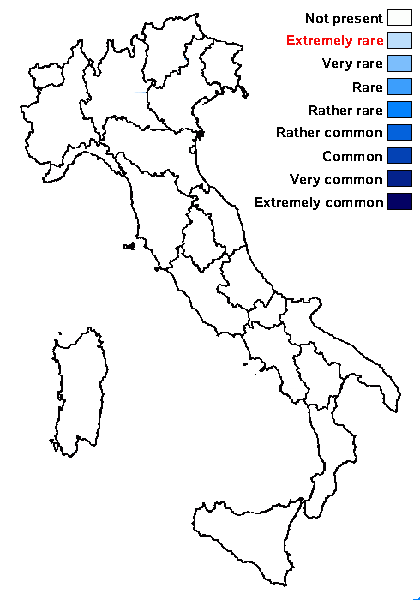Lecanora burgaziae I. Martínez & Aragón
Bryologist, 107, 2: 223, 2004
Synonyms: Straminella burgaziae (I. Martínez & Aragón) S.Y. Kondr., Lőkös & Farkas
Distribution:
Description: Thallus crustose, endosubstratic or thinly episubstratic and consisting of 0.03-0.1 mm wide, convex areoles, yellowish or yellowish green, without a distinct prothallus. Apothecia lecanorine, round to rarely irregular in outline, sessile and weakly constricted at base, (0.3-)0.4-0.7(-1) mm across, with a greenish to brownish, slightly concave to flat, dull, epruinose disc and a weakly prominent, granular-knobby, homogeneously coloured, persistent thalline margin. Thalline exciple corticate, 70-110 µm thick laterally, 80-123 µm thick at base, the cortex 10-23 µm thick laterally, 50-60 µm at base, with granules in outer part, the hyphae with c. 1 µm wide lumina, the medullary part rich in algae; proper exciple thin, colourless; epithecium colourless to ochre-brown, 6-13 µm high, with many small yellow-brown granules soluble in K; hymenium colourless, 40-50 µm high; paraphyses simple or sparingly branched and anastomosing, 1-1.5 µm thick at mid-level, the apical cells 1.5-2 µm wide; hypothecium colourless in upper part, pale yellow in lower part, 40-50 µm high. Asci 8-spored, clavate, very thin-walled, with a K/I+ blue, tall tholus penetrated by a faintly amyloid apical cushion, the wall K/I-, surrounded by a blue outer layer, Lecanora-type. Ascospores 1-celled, hyaline, ellipsoid, (10-)11-12.5(-13) x 5-7.5 µm. Photobiont chlorococcoid. Spot tests: thallus K-, C-, KC- or KC+ pale yellow, P+ bright yellow, UV+ dull orange. Chemistry: usnic, psoromic and 29-O-demethylpsoromic acids.
Note: this species, known from the central parts of the Iberian Peninsula, grows both on fallen pine cones and on branches of Cistus; it should be looked for also in Mediterranean Italy, especially in Sardinia.
Growth form: Crustose
Substrata: bark
Photobiont: green algae other than Trentepohlia
Reproductive strategy: mainly sexual

Predictive model
Growth form: Crustose
Substrata: bark
Photobiont: green algae other than Trentepohlia
Reproductive strategy: mainly sexual

Predictive model
 INDEX FUNGORUM
INDEX FUNGORUM
 GBIF
GBIF

